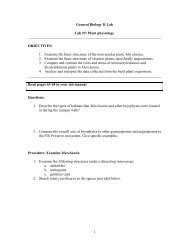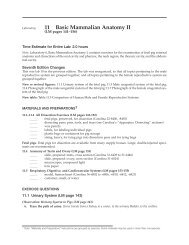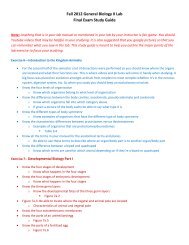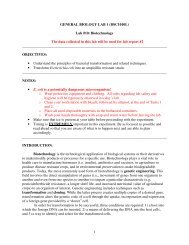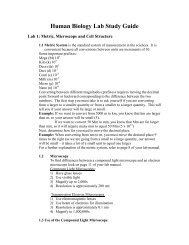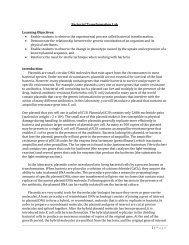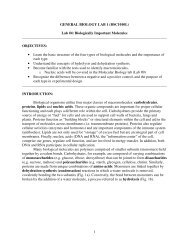Exercise 3: Membranes
Exercise 3: Membranes
Exercise 3: Membranes
Create successful ePaper yourself
Turn your PDF publications into a flip-book with our unique Google optimized e-Paper software.
<strong>Exercise</strong> 3: <strong>Membranes</strong>__________________________________________________________________________________________________________________OBJECTIVES:• Investigate the nature of the cell membrane• Explore how compounds or molecules pass through differentially permeable membranes• Investigate Osmoregulation__________________________________________________________________________________________________________________CELL MEMBRANESWhether cells comprise whole unicellular organisms or are part of larger multicellular bodies,they need to find a way to communicate with their environment, i.e., to transport nutrients and chemicalsignals from surrounding cells while keeping unwanted molecules/chemicals/toxins from entering the cellinterior. Cells accomplish all this with the use of cell membranes.According to the fluid mosaic model, biological membranes consist of a phospholipid bilayerincluding a mobile mosaic of proteins dispersed throughout the fluid-like lipid layer. A phospholipidmolecule is composed of a phosphate group and two fatty acids bonded to a glycerol molecule (Fig 1).Because of their amphipathic (hydrophobic and hydrophilic) nature, phospholipids self-assemble into adouble-layered sheet (i.e., a bilayer) with the hydrophilic (“water-loving”) phosphate and glycerol layers(heads) lining both the inner and outer cell surfaces and the hydrophobic (“water-fearing”) fatty-acidlayers (tails) forming the inner core of the membrane (Fig. 2). The head-to-tail arrangement ofphospholipids in the membrane enables cells to be selectively and differentially permeable allowingonly small, nonpolar and lipid-soluble molecules to pass through the bilayer. Molecules that are too large,polar and/or hydrophobic can only enter the cell via transmembrane proteins. These proteins permit andfacilitate the passage of specific molecules and polar ions across the membrane and also serve asreceptors for communication between cells.Figure 1. Structure of a Phospholipid1
OutsidePolar hydrophilicheadsNonpolar hydrophobictailsInsideBPolar hydrophilicheadsAFigure 2. A. Fluid Mosaic model of the Cell Membrane B. General Structure of the PhospholipidBilayer1. What determines the flow of water through the membrane?Task 1 - OSMOSIS AND CONCENTRATION GRADIENTSOsmosis is the diffusion of water across a selectively permeable membrane. Osmosis follows thesame laws as diffusion but always refers to water, the principal solvent in cells. A solution is ahomogenous mixture of two or more substances. In a solution, the solvent is the fluid while the solute isthe substance being dissolved in the solvent.Osmosis (Fig. 3) can be simulated using dialysis bags to model cells in different environments,i.e., under hypo-, hyper and isotonic conditions. The terms hypo-, hyper- or isotonic are always relative tothe concentration of the solutes outside.The exercise that follows will allow you to learn about the properties of osmosis in relation toconcentration of solutions.Concentration Hypotonic Isotonic HypertonicSolute inside Low Same HighSolute outside High Same LowTable 1. Osmosis2
Procedure:1. Fill the bowl at your station with tap water.Figure 3. Osmosis2. Fill the 250mL beaker at your station with 25% sucrose.3. Team up into pairs within your group. Each pair will be responsible for preparing two dialysisbags. Team one will prepare Bags A and B with 10mL of tap water. Team two will prepare Bag Cwith 10mL 10% sucrose and Bag D with 10mL 25% sucrose. Make sure to include a label(written in pencil) into the correct bag.4. Once the four bags are prepared, carefully dry them with a paper towel. Weigh each bag on thescale provided and record the weights in Table 5.5. Simultaneously, place Bag A in 250mL beaker containing 25% sucrose and bags B, C and D intothe large bowl of tap water. Set your timer for 15 min.6. After each 15 min interval (total time = 60 min) remove each bag, dry and weigh it. Record theweight for each bag in Table 5. After weighing, place the bags back into the correct beaker, andthen calculate the change in weight from the previous measurement taken.Based on what you know about osmosis, formulate scientific hypotheses and statistical (H oand H a) for what you expect to occur (in relation to bag weight) in each of the bags overtime. Write both hypotheses in the space provided and explain your reasoning for each.Scientific:H o:H a:3
MAKE PREDICTIONS:Bag ABag BBag CBag DFigure 4: Using the figure 2a-d above, draw in the movement of water according to yourpredictions. Use the table below to explain the reasoning for your predictions.BagAExplanationBCDTable 2. Osmosis Experiment Predictions4
Table 3: Observed Results0 min 15min 30min 45min 60minBag AInitialWt.TotalWt.Wt.ChangeTotalWt.Wt.ChangeTotalWt.Wt.ChangeTotalWt.Wt.ChangeBag BBag CBag D• Using Excel, construct a graph that depicts the changes noted in each bag over time. Make sureto label the axes correctly and plot each bag as a separate curve.Questions:2. Describe any changes observed or measured during your experiment. Did these supportyour predictions? Explain.Bag A:Bag B:Bag C:Bag D:3. Describe any problems you may have encountered during your experiment. Did this affectyour results? If so, explain how.4. (a) Is your null hypothesis or alternative hypothesis supported by your data? Explain. (b)Do you reject or fail to reject your null hypothesis?5
5. Which bag had the highest rate of osmosis? How can you tell? Why?Task 2: Brownian MovementBrownian movement is the random movement of molecules in response to heat. Thisphenomenon can be observed by placing a Carmine red suspension (Carmine red dye mixed with soap)under the microscope.1. Place a small drop of the Carmine red suspension on a clean slide. Add a coverslip.2. Examine this slide with the microscope. Once in focus, look for movement (vibration) of the reddye molecules. Be patient, it may take the microscope light a few minutes to heat up your slide.Describe you observations in the space belowQuestions:6. What factors control the Brownian Motion?7. What direction are the particles moving?8. How does Brownian motion affect the rate of diffusion?______________________________________________________________________________Task 3 - DIFFUSION AND DIFFERENTIALLY PERMEABLE MEMBRANESDiffusion is the passive movement of a substance from an area of high concentration to an area oflow concentration (Fig. 8). The speed at which movement occurs depends on the concentration gradientbetween the two areas but can also be affected by the weight/size of the substance.6
Fig. 4.26Figure 5. DiffusionIn this exercise, you will examine the property of selective/differential permeability usingdialysis tubing to represent the cell membrane. Dialysis tubing has small pores that allow smallermolecules to pass through while the larger ones are retained. You will use two indicators:phenolophthalein and iodine. Phenolphthalein is a pH indicator that turns pink in basic solutions andIodine is a starch indicator that changes from yellow to blue/black in the presence of starch.Procedure:1. Before proceeding with this experiment, read through the set-up and discuss what you expect tosee and why.2. Team up into pairs within your group. Each pair will work on a dialysis tube preparation. Yourinstructor will demonstrate to the class how to prepare the dialysis bags.3. Each pair should begin with one dialysis bag. Seal one end of the bag by tying it into a knot. Oncesealed, Team 1 will add 10mL of water and then 3 drops of phenolpthalien to their bag (Table 2)while Team 2 will add 10mL of starch suspension (Table 3). Following the addition of theaforementioned substances, each team should then knot the open end of their bag.4. Add 200ml of tap water followed by 10 drops of Sodium hydroxide to a 250mL beaker. Team 1should place their bag containing the phenolpthalien into this beaker (Table 2).5. To another 250mL beaker add 200mL of tap water followed by 40-60 drops of iodine. Team 2should place their bag containing the starch suspension into this beaker (Table 3).7
Based on what you know about diffusion, formulate scientific hypotheses and statistical (H oand H a) for what you expect to occur in each of the bags over time. Write both hypotheses inthe space provided and explain your reasoning for each.Scientific:H o:H a:MAKE PREDICTIONS:Team 1 Team 2Figure 6. Diffusion Experiment PredictionsTeam1Explanation2Table 4. Diffusion Experiment Prediction ExplanationBased on what you know about diffusion, formulate scientific hypotheses and statistical (H oand H a) for what you expect to occur in each of the bags over time. Write both hypotheses inthe space provided and explain your reasoning for each.Scientific:H o:H a:8
• Observe each beaker for no more than 30 minutes. Note any color changes in the two bags’contents and the surrounding solutions in the space provided.Questions:9. What is the best explanation for the color change that occurred?10. Based on your results, which molecules (phenopthalien, iodine, starch, sodium hydroxide)passed through the membrane? Explain.Team 1:Team 2:11. Based on your results, which molecules (phenopthalien, iodine, starch, sodium hydroxide)did not pass through the membrane? Explain.Team 1:Team 2:12. Describe any problems you may have encountered during your experiment. Did this affectyour results? If so, explain how.13. (a) Is your null hypothesis or alternative hypothesis supported by your data? Explain. (b)Do you reject or fail to reject your null hypothesis?9
14. What reasons can you provide for the movement of these molecules across the membraneand not others?Task 4 - DIFFUSION OF GASESGas molecules are perpetually in random, rapid motion. Thus, they diffuse through any container veryquickly. For instance, when a bottle of cologne is opened up in a room, the fragrance can quickly besmelled throughout the entire room. The rate of gas diffusion is very much dependent on the molecularweight of the gas being used. With the experimental setup in front of you it is possible to determine effectof molecular weight on the diffusion of gases. If concentrated HCl is introduced at one end of a glass tubeand NH 4 OH at the other, the gases, HCl and NH 3 , diffuse toward the center. HCl has a molecular weightof 36 and NH 3 a molecular weight of 17. When both gases meet, they form NH 4 Cl, a white salt (not agas) that precipitates as a ring in the tube.Procedure:1. Remove the stoppers and simultaneously dip one swab in concentrated HCl and the other inconcentrated NH 4 OH.2. Reinsert the stoppers back into the tube at the same time.3. Observe the formation of a white ring of NH 4 Cl.Formulate scientific, null and alternative hypotheses describing which gas should move fasterand why? State each in the space provided below.Scientific:H o:H a:NOTE: This procedure will be demonstrated by your TA.CAUTION:• HCl is a concentrated acid and can harm you and your clothes.• NH 4OH is very irritating to the eyes and nose.10
Using a ruler, measure the distance (cm) that each gas traveled in the tube. Record these distancesin the space provided below.NH 4 OH: ________________HCl: _____________________Questions:15. What is the ratio of HCl: NH 4OH distances?16. What is the ratio of the molecular weights?17. Is diffusion rate directly or inversely proportional to molecular weight?18. Do you reject or fail to reject your null hypothesis? Explain.19. How would an increase in temperature affect the rate of gas diffusion?Task 5 - HEMOLYSIS OF BLOOD CELLSBlood cells provide an additional model to study osmosis and diffusion. If blood cells areplaced in a hypotonic solution, water will rush in causing the cells to swell and eventually burst(hemolysis). On the other hand, if blood cells are placed in a hypertonic solution, water will rushout of the cells and they will crenate or shrivel (Fig. 7).Figure 7. Osmosis in Red Blood Cells11
Procedure:1. Obtain three pre-measured test tubes of sheep blood from the refrigerator and label them1-3.2. To tube 1 add 5mL of 10% NaCl, to tube 2, 5mL 0.9% NaCl and to tube 3, 5mL ofdistilled water.3. Cover each tube with parafilm before inverting to mix the solutions.4. Formulate hypotheses (Scientific, H o and H a ) regarding your expectations for theoutcome to the blood cells in each tube. State your hypotheses in the space provided.Make sure to include your reasoning.5. Hold each tube in front of a printed page to determine whether or not you can read theprint through the solution. Record your results in Table 6.Formulate hypotheses (Scientific, H o and H a) regarding your expectations for the outcome to theblood cells in each tube. State your hypotheses in the space provided. Make sure to include yourreasoning.Scientific:H o:H a:12
MAKE PREDICTIONS in Table 5:Tube#ContentsReadable Print(yes/no)Explanation15mL 10% NaCl25mL 0.9% NaCl35mL distilledwaterTable 5. RBC Predictions TableNote: Hold each tube in front of a printed page to determine whether or not you can read the printthrough the solution. Record your results in Table 5.Table 6:Tube#ContentsReadable Print(yes/no)Explanation1 5mL 10% NaCl2 5mL 0.9% NaCl3 5mL distilledwaterQuestions:20. Did the results correspond to your predictions?21. Describe any problems you may have encountered during your experiment. Did this affectyour results? If so, explain how.13
22. (a)Is your null hypothesis or alternative hypothesis supported by your data? Explain. (b) Doyou reject or fail to reject your null hypothesis?23. If person’s blood volume drops due to injury or sever dehydration, why do doctorsadminister isotonic saline intravenously instead of pure water?24. What osmotic regulatory challenges would a fish living in freshwater have versus a fishliving in salt water?Task 6: OsmoregulationOsmosis is the transport of water through a semi-permeable membrane down itsconcentration gradient. Osmosis is responsible for the fluid transport out of the kidney tubules andgastrointestinal tract, into capillaries, and across cell membranes. Tonicity classifications arerelative terms describing the concentration of one environment to another. Hypertonic solutionscontain a higher solute concentration than a compared solution. When concentrations are the samebetween both solutions, they are isotonic. Hypotonic refers to a solution that has a lower soluteconcentration than the solution on the opposing side of the membrane.Organisms maintain homeostasis through osmoregulation, the active regulation of theosmotic pressure of their fluids. Osmotic pressure comes from the ability of a solvent and theinability of a solute to pass through a semi permeable membrane. When cells are placed in extremeenvironments, drastic effects on the cells can be observed. Sheep’s red blood cells lyse when placedin a hypotonic solution, a process called hemolysis. When plant cells are placed in hypertonicsolutions plasmolysis occurs. This process involves the loss of water through osmosis, whichcauses the plant’s plasma membrane to pull away from the cell wall. Today you will subject livingcells to environments with different concentrations of a solute and observe their responses.Directions: In the table below, predict the reaction of the following cell types in the differentenvironments.14
Table 7. PredictionsExtracellular EnvironmentAnimalHypotonic__________ % NaClIsotonic__________ % NaClHypertonic__________ % NaClSheep’sBlood(RBC)Plant(Elodea)I. Sheep’s Blood- Red Blood Cells1. Place a drop of the blood from tube 1 (from Task 5) onto a clean slide and then add a coverslip. Repeat the same procedure for tubes 2 and 3. Mark the slides with the appropriate tubenumber so that you can be certain which slide contains blood from which tube.2. Examine each slide under the microscope. Determine if the cells are crenate (shriveled),have burst (so only fragments remain) or whether they appear healthy and round. Recordthe results in Table 7.II. Cheek Cells1. Using a toothpick, gently scrape the inside of your cheek. Add one drop of the isotonic NaClsolution to a clean slide. Stir the scrapping from the toothpick into the drop of water andthen add a drop of methylene blue followed by a coverslip. Repeat this procedure for thehypertonic and hypotonic solutions.2. Examine each slide under the microscope. Determine if the cells are crenate, lysed, orappear healthy and round. Record your results in Table 7.15
III. Elodea Cells1. Collect one leaf from a spring of Elodea. Add a drop of isotonic solution to a clean slide. Placethe leaf, with the top surface facing up, in the drop of isotonic solution on the slide. Add acoverslip.2. Examine each slide under the microscope. Record your results in Table 7.Table 8. Observed ResultsExtracellular EnvironmentAnimalHypotonic__________ % NaClIsotonic__________ % NaClHypertonic__________ % NaClSheep’sBloodPlant(Elodea)Figure 8. Response of plant cells to a. hypotonic and b. hypertonic extracellular environments16
Questions:25. Compare and contrast the reaction the animal cell had to the hypotonic solution comparedto the plant cell.26. Compare and contrast the reaction the animal cell had to the hypertonic solution comparedto the plant cell.27. What factors might affect the speed of water movement in or out of a cell?28. Did the results correspond to your predictions?29. Describe any problems you may have encountered during your experiment. Did this affectyour results? If so, explain how.30. (a)Is your null hypothesis or alternative hypothesis supported by your data? Explain. (b) Doyou reject or fail to reject your null hypothesis?17
______________________________________________________________________________Response of Single Celled Organisms to Environmental StimuliLiving organisms respond to outside stimuli. Their ability to sense and respond to the localenvironment increases their survival rate. In this exercise, you will design an experiment toexamine the response of an Amoeba to a particular environmental stimulus.31. Choose the stimulus that you would like to test (e.g. temperature, light, salinity, acidity) andrecord it below.32. Formulate hypotheses (H o and H a) about your predictions on how you expect the Amoeba toreact in response to the stimulus. Write your hypotheses in the space provided.33. Decide how to test your hypotheses. Describe your experimental design in the space below:18



